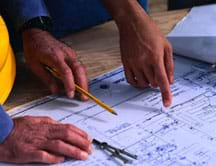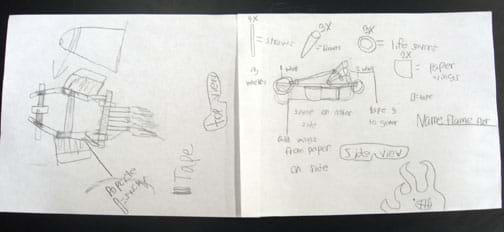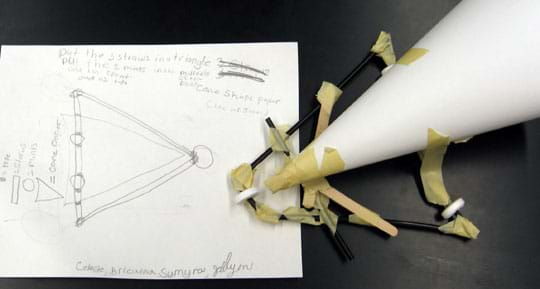Quick Look
Grade Level: 4 (3-5)
Time Required: 1 hour
Expendable Cost/Group: US $2.00
Group Size: 3
Activity Dependency: None
Associated Informal Learning Activity: The Language of Engineering Drawings
Subject Areas: Measurement, Problem Solving, Science and Technology
NGSS Performance Expectations:

| 3-5-ETS1-1 |
| 3-5-ETS1-2 |
Summary
Students practice the ability to produce clear, complete, accurate and detailed design drawings through an engineering design challenge. Using only the specified materials, teams are challenged to draw a design for a wind-powered car. Then, they trade engineering drawings with another group and attempt to construct the model cars in order to determine how successfully the original design intentions were communicated through sketches, dimensions and instructions.
Engineering Connection
Engineering is about applying mathematical and scientific knowledge to design. To be successful as an engineer, a person must be able to accurately communicate one's design intentions to clients, manufacturers and end users through the use of drawings, specifications and instructions. This is true for all types of engineering, across all languages. Failures in the engineering communication process result in the loss of money, time, materials, and in extreme circumstances, injury and death.
Learning Objectives
After this activity, students should be able to:
- Describe how drawing and communication are important to the engineering design process.
- Communicate a simple engineering design through the use of a drawing with detailed instructions.
- Accurately measure and cut materials as specified in a design drawing.
Educational Standards
Each TeachEngineering lesson or activity is correlated to one or more K-12 science,
technology, engineering or math (STEM) educational standards.
All 100,000+ K-12 STEM standards covered in TeachEngineering are collected, maintained and packaged by the Achievement Standards Network (ASN),
a project of D2L (www.achievementstandards.org).
In the ASN, standards are hierarchically structured: first by source; e.g., by state; within source by type; e.g., science or mathematics;
within type by subtype, then by grade, etc.
Each TeachEngineering lesson or activity is correlated to one or more K-12 science, technology, engineering or math (STEM) educational standards.
All 100,000+ K-12 STEM standards covered in TeachEngineering are collected, maintained and packaged by the Achievement Standards Network (ASN), a project of D2L (www.achievementstandards.org).
In the ASN, standards are hierarchically structured: first by source; e.g., by state; within source by type; e.g., science or mathematics; within type by subtype, then by grade, etc.
NGSS: Next Generation Science Standards - Science
| NGSS Performance Expectation | ||
|---|---|---|
|
3-5-ETS1-1. Define a simple design problem reflecting a need or a want that includes specified criteria for success and constraints on materials, time, or cost. (Grades 3 - 5) Do you agree with this alignment? |
||
| Click to view other curriculum aligned to this Performance Expectation | ||
| This activity focuses on the following Three Dimensional Learning aspects of NGSS: | ||
| Science & Engineering Practices | Disciplinary Core Ideas | Crosscutting Concepts |
| Define a simple design problem that can be solved through the development of an object, tool, process, or system and includes several criteria for success and constraints on materials, time, or cost. Alignment agreement: | Possible solutions to a problem are limited by available materials and resources (constraints). The success of a designed solution is determined by considering the desired features of a solution (criteria). Different proposals for solutions can be compared on the basis of how well each one meets the specified criteria for success or how well each takes the constraints into account. Alignment agreement: | People's needs and wants change over time, as do their demands for new and improved technologies. Alignment agreement: |
| NGSS Performance Expectation | ||
|---|---|---|
|
3-5-ETS1-2. Generate and compare multiple possible solutions to a problem based on how well each is likely to meet the criteria and constraints of the problem. (Grades 3 - 5) Do you agree with this alignment? |
||
| Click to view other curriculum aligned to this Performance Expectation | ||
| This activity focuses on the following Three Dimensional Learning aspects of NGSS: | ||
| Science & Engineering Practices | Disciplinary Core Ideas | Crosscutting Concepts |
| Generate and compare multiple solutions to a problem based on how well they meet the criteria and constraints of the design problem. Alignment agreement: | Research on a problem should be carried out before beginning to design a solution. Testing a solution involves investigating how well it performs under a range of likely conditions. Alignment agreement: At whatever stage, communicating with peers about proposed solutions is an important part of the design process, and shared ideas can lead to improved designs.Alignment agreement: | Engineers improve existing technologies or develop new ones to increase their benefits, to decrease known risks, and to meet societal demands. Alignment agreement: |
Common Core State Standards - Math
-
Generate measurement data by measuring lengths using rulers marked with halves and fourths of an inch. Show the data by making a line plot, where the horizontal scale is marked off in appropriate units— whole numbers, halves, or quarters.
(Grade
3)
More Details
Do you agree with this alignment?
International Technology and Engineering Educators Association - Technology
-
Apply the technology and engineering design process.
(Grades
3 -
5)
More Details
Do you agree with this alignment?
-
Follow directions to complete a technological task.
(Grades
3 -
5)
More Details
Do you agree with this alignment?
State Standards
Colorado - Math
-
Appropriate measurement tools, units, and systems are used to measure different attributes of objects and time.
(Grade
4)
More Details
Do you agree with this alignment?
Materials List
Each group needs:
- 5 popsicle sticks
- 5 straws
- 4 Lifesaver mint candies
- 2 sheets of paper
- pencil or pen
- masking tape
- ruler, for measuring dimensions
- scissors
- Engineering Drawing Survey Sheet
For the teacher:
- (optional) Example Engineering Drawings, a student handout or overhead transparency
- (optional) overhead projector (if showing example engineering drawings)
Worksheets and Attachments
Visit [www.teachengineering.org/activities/view/cub_engrdrawings_activity01] to print or download.Introduction/Motivation
How many of you have ever helped your mom or dad bake something, such as cookies or brownies? Have any of you ever bought toys, such as a LEGO ship or tower, in which you had to put the toy together yourself? In both of these cases, you had to follow someone else's instructions to get the results you wanted.
Engineering drawings must be clear and correct. When engineers fail to accurately communicate their ideas, expensive materials can be cut to the wrong size and ruined, systems can be completed improperly and require expensive changes in order to be adapted back to the original intent, and structures and machinery can fail, resulting in property damage and loss of life. Engineers must also take great lengths to model and test every part of a design before completing the final prototype or full size-model. We call this process the engineering design process. By constructing models at a small scale and conducting different tests on them, engineers are able to identify where models might fail and decide what changes would make the design better. Through the cycle of designing, building models, testing, and re-designing, engineers are able to produce final prototypes, drawings and instructions that accurately reflect the intended product.
Today, we want to focus on communicating our design intentions through the use of an engineering drawing. Good engineers spend a lot of time producing drawings with detailed dimensions and material specifications that communicate their ideas accurately to others. In the real world, it is often another type of specialist who manufactures the actual model or prototype based on an engineer's design drawing. This makes good detail and clarity even more important when an engineer is producing a drawing.
In today's activity, we will practice producing an accurate engineering design drawing through a simple engineering design challenge. Using only the materials provided, you will draw a detailed design for a model car that is powered by the wind. The goal of the design is to have the car travel as far as possible on a single puff of air (blown from your mouth). Once your detailed design drawing is complete, you will trade drawings with another group who will construct your model car and give you feedback on the clarity, completeness, detail and accuracy of your drawings.
Procedure
Background
Engineering drawings have traditionally been known as blueprints due to the original method of printing these drawings that used a chemical process that resulted in white lines on a blue background or vice versa. This process has since become obsolete, but the name "blueprint" is still often used to describe engineering drawings.
Today's engineering drawings are produced almost exclusively through the use of specialized computer programs. The production of high-quality engineering drawings is essential to the engineering process. A good engineering drawing accurately specifies the geometry, dimensions, tolerances, material, and finish associated with a given engineered component. The use of a variety of different viewpoints and detailed "cuts" (or cross-sections) ensures that an appropriate level of detail is communicated to the fabricator. For more information, please refer to Design and Technology on the Web's Engineering Drawing and Sketching page: http://www.design-technology.info/engineering/index.htm
Before the Activity
- Gather materials and separate into enough sets for each group.
- Print out a few handout copies or an overhead transparency of the Example Engineering Drawings, and/or find other examples of engineering drawings on the Internet.
- Make copies of the Engineering Drawing Survey Sheet.
With the Students
- Divide the class into groups of two or three students each. (Alternatively, have students work individually, although engineers typically work in teams.)
- Explain the steps of the engineering design process to the class (see Vocabulary section). Ask students what can happen when engineers do not communicate effectively.
- Emphasize the importance of engineering design drawings. Show students examples of what real engineering designs look like. (Show the attached Example Engineering Drawings and/or find examples on the Internet; see the example sources provided in the Additional Multimedia Support section.)
- Briefly explain the engineering design challenge to students: Using only the provided materials, your challenge is to design a wind-powered car that will travel the furthest on a single puff of air. You must create an engineering drawing to clearly and completely communicate your design, such that another group can build it as you imagined it.
- Distribute the materials to each group. The materials are for reference only. The students may touch them but are not allowed to connect or change them in any way. Using paper and pencil, direct the students to draw a detailed design of their wind-powered car. Remind them to label their drawings with dimensions, materials and instructions. Make sure students are not rushed and spend a lot of time on the drawings.

An example wind-powered car design drawing by fourth-grade students. - Have teams trade completed designs with another group. Either have individual teams trade or rotate the designs around the room.
- Give students some time to (attempt to) construct the other groups' designs. If the students are too confused by the designs, allow them a brief meeting with the original designers. This simulates the real-life scenario of a change order or project meeting.

A completed wind-powered car prototype next to its design drawing. - When students are finished constructing their designs, test the models as a class. Mark off a starting line with tape. Have each group provide "one-puff" power for testing. Measure and record results.
- After testing, go through several iterations of testing and modification (as described in the Assessment section). Have the designer groups make improvements to their original design drawings. Have the builder groups incorporate the design changes into the model, following the new instructions. As time permits, go through several design cycles.
- Conclude by handing out the Engineering Drawing Survey Sheets so students can give each other feedback on the clarity, accuracy, completeness, and instructions provided in their engineering drawings.
Vocabulary/Definitions
blueprint: A print of an architectural or mechanical drawing produced by a chemical process that results in white lines on a blue background or blue lines on a white background. Now commonly refers to any paper copy of an engineering drawing.
CAD drawing: Computer-aided design drawing: An engineering drawing produced using specialized computer software such as AutoCAD.
chassis: The frame, wheels and machinery of a motor vehicle, on which an exterior body is supported.
engineering design process: The process engineers follow when designing anything. While many variations exist, three basic steps are always involved: designing, building, and testing. This sequence of steps is always performed in a cyclical or spiral pattern (it is not a linear process) in which the design is improved through each cycle.
engineering drawing: A technical drawing that fully and clearly defines the requirements for engineered items. It accurately and unambiguously captures all the geometric features of a product or a component. Its purpose is to convey all the required information necessary for a manufacturer to produce that component.
Assessment
Pre-Activity Assessment
Class Discussion: Provide examples of several engineering drawings for students to examine. (Use the attached Example Engineering Drawings, and see the Additional Multimedia Support section.) Ask the students:
- What important features do you notice in each of these drawings? What would be important to communicate so someone could build a design by only looking at the engineering drawing? (Possible answers: Dimensions, labels, material specifications, different viewpoints, notes, etc.)
Activity Embedded Assessment
Design Testing and Modification: When all groups have completed their wind-powered car construction, have each group choose one member to be their "puffer" and test each car sequentially, in front of the class. Have the original designers make changes (improvements!) to the original design drawing based on construction and test results. Have the "construction" group incorporate the design changes into the model, following the designers' instructions. Depending on time, go through several design cycles.
Post-Activity Assessment
Worksheet: Have the students complete the Engineering Drawing Survey Sheet as a way to give feedback to the original designers. Encourage constructive criticism and positive feedback.
Troubleshooting Tips
Make sure that you emphasize the addition of a lot of detail in the drawings, including actual dimensions if possible. Unclear drawings can lead to a lot of frustration for the group attempting to construct a given design.
Activity Extensions
Research: Challenge the students to research some of the different catastrophes that have occurred due to miscommunications in the engineering design process. Have them share their findings with the rest of the class. One classic example involves the accidental destruction of the Mars Climate Orbiter due to the use of English units instead of metric units in communications between NASA and Lockheed Martin. Read a recap at: http://mate.dm.uba.ar/~jetchev/Horror/CNN%20-%20NASA%20Human%20error%20caused%20loss%20of%20Mars%20orbiter%20-%20November%2010,%201999.htm
Global Context: Have students think about how they could communicate their design to engineering students in another country. Discuss how engineering companies often work with companies in other countries to produce a final product, such as the International Space Station and even the different structures and requirements needed for the Olympic games. Engineering designs are often shared between or created by people who speak different languages. How might students adjust their car designs to reflect this need?
Activity Scaling
- For lower grades, give students a standard design for the sail portion of the car so their unique designs only involve designing the frame (chassis).
- For upper grades, leave the design process completely open ended. Give students additional materials to work with and require them to provide dimensions for each piece to be installed on the car.
Additional Multimedia Support
The SolidWorks CAD design website has many cool pictures in their Design Gallery, including some made by K-12 students. See http://www.solidworks.com/sw/successes/gallery.htm
See another example engineering drawing at AccuTechUSA's Sample Engineering Drawing website at http://www.accu-techusa.com/images/drawing1.jpg
Subscribe
Get the inside scoop on all things TeachEngineering such as new site features, curriculum updates, video releases, and more by signing up for our newsletter!More Curriculum Like This

During this lesson, students discover the journey that a Mars rover embarks upon after being designed by engineers and before being prepared for launch. Students investigate the fabrication techniques, tolerance concepts, assembly and field-testing associated with a Mars exploratory rover.

Students are introduced to detail drawings and the importance of clearly documenting and communicating their designs. They are introduced to the American National Standards Institute (ANSI) Y14.5 standard, which controls how engineers communicate and archive design information.
References
Dictionary.com. Lexico Publishing Group, LLC. Accessed November 10, 2009. (Source of some vocabulary definitions, with some adaptation) http://www.dictionary.com
Engineering Drawing. Last updated October 27, 2009. Wikipedia, The Free Encyclopedia. Accessed November 10, 2009. http://en.wikipedia.org/wiki/Engineering_drawing
Engineering Drawing and Sketching for GCSE. Last updated June 20, 2007. Guide to Engineering Drawing Conventions, Design Cycle, Drawing Conventions, and Graphic Products. Design and Technology on the Web. Accessed November 10, 2009. http://www.design-technology.info/IndProd/default.htm
Puff-mobile, Science Rocks. ZOOM Activities from the Show, PBS Kids, WGBH. Accessed November 10, 2009. http://pbskids.org/zoom/activities/sci/puffmobile.html
Copyright
© 2009 by Regents of the University of Colorado.Contributors
Jacob Crosby, Malinda Schaefer Zarske, Denise W. CarlsonSupporting Program
Integrated Teaching and Learning Program, College of Engineering, University of Colorado BoulderAcknowledgements
The contents of this digital library curriculum were developed under a grant from the Fund for the Improvement of Postsecondary Education (FIPSE), U.S. Department of Education and National Science Foundation GK-12 grant no. 0338326. However, these contents do not necessarily represent the policies of the Department of Education or National Science Foundation, and you should not assume endorsement by the federal government.
Last modified: January 12, 2018








User Comments & Tips